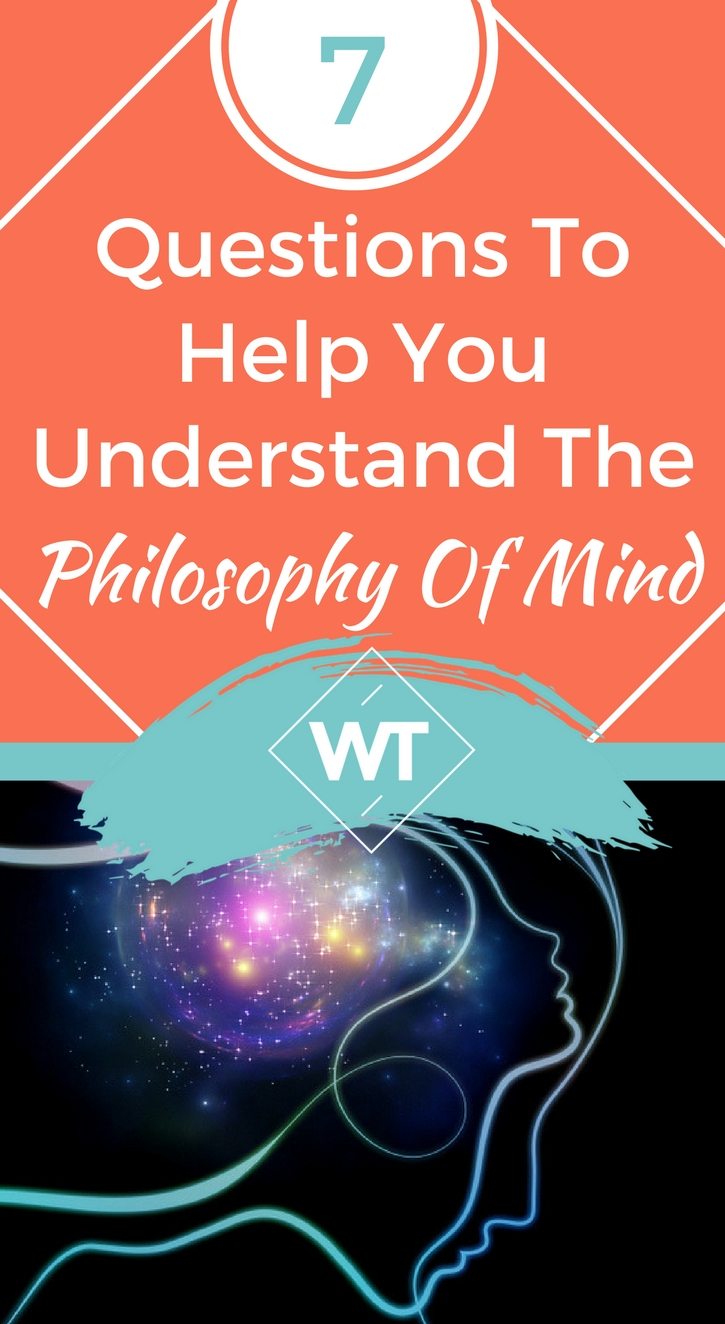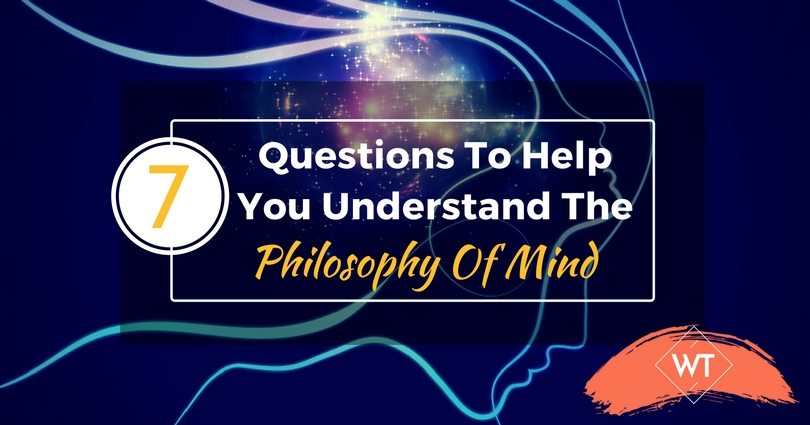7 Questions To Help You Understand The Philosophy Of Mind

One of the most intriguing topics in western Philosophy is the Philosophy of Mind because of its wide-ranging debates, controversial theories, and ever-changing landscape as more research reveals new facets we didn’t know even a year ago.
It’s hard to navigate through a vast subject in a short space, but by asking the right questions one can hit the most important points in the most concise way possible.
Here are some of the most important questions that are asked about the concept behind mind and the philosophy of mind itself:
1. What is mind?
The biggest question of all and the straight answer is that we don’t yet have a clue; or, to be more kind, we are still far from a complete picture. The idea of mind has been theorized in both Western and Eastern cultures for millennia.
One of the popular views is that mind is more akin to computer software or a program that runs on top of its hardware (the brain). This ‘software’ is both pre-programmed and re-programmed as we experience, learn and grow, while the hardware does the connections (the ‘re-wiring’ and processing).
This view, although popular, created some new problems in the philosophy of mind, and recalled some very old ones. One such problem is the so-called Mind-Brain duality; in other words, is our mind a separate entity from our physical brain? If so, how do these two separate entities relate to each other?
Or if the mind is immaterial (and therefore beyond space and time) what does it say about our reality? (And this opens up other questions which take us on to some weirdness such as quantum fields and non-locality.)
Some suggest that the mind is an emergent phenomenon, that is, it’s an effect which emerges spontaneously from the physical processes in the brain but is something different and ‘novel’ and cannot be explained by reducing it to their material brain processes.
It is a new whole (the mental) created from the parts (the physical brain processes) but the whole is bigger than the sum of its parts. It is qualitatively ’new’. This view has also its flaws and problems. For one, it doesn’t escape the mind-brain duality.
2. Is the mind inside our brain?
The classical view of science has always been materialist and reductionist, that is, it tries to explain things by reducing them to material and physical stuff and processes. Hence, according to this view, the mind is nothing more than the brain or to put it in another way: your mind is in your brain.
This view has been so widespread that it is taken for granted by everyone—even those who are not scientifically minded. We think that our mind is in our head.
The curious thing is that if you ask children before a certain age where is their mind they will not naturally tell you that their mind is located in their head. Yet, when older children are asked the same question, they will automatically point at their heads. Clearly this is just an idea we learn from society rather than being self-evident.
According to many scientists, all our mental states—ideas, thinking, abstraction, imagination, etc.—can all be explained by some neurological correlate which can be discovered as our brain scanning instruments become more and more sophisticated.
So for instance, a fear you may have had imprinted in you since a particular event when you were a child can be ultimately found in some set of connections between neural cells in your brain.
This scientific view is being more and more challenged recently. There are so many counter-examples which point at the possibility that our mind is not localized in our brain.
Millions of people for instance have had out of body experiences (OOBEs) or near-death experiences (NDEs) where they have successfully gotten information about places, people or objects that could not have been accessible to them because their body was lying hundreds of miles away from the event they described.
Some other ‘psychic’ phenomena shows how some people experienced an event or situation before it happened and gave precise information about it. Even perhaps less extreme is the idea of how often we can feel that somebody is staring at us even if we can’t see them or how, for example, our phone rings and we immediately sense who the person is that’s calling. This is not speculation. All these non-ordinary occurrences have been studied multiple times using a large set of subjects and experimental setups.
So in short, new research outside the limits of conventional scientific studies are increasingly challenging the idea that our minds are located in our brains. This of course has widespread implications into the subject of consciousness (which I will not touch upon here for practical reasons).
3. Can we know other minds? (The problem of other minds)
Our perception or mental states are ‘internal’ or subjective in the sense that when you see an object, what you are seeing is not the actual object but an internal representation of that object. The light reflecting off that object hits the retina of the eye and signals travel through the optic nerve which are then translated by your brain into an image.
For example, there is nothing like the color white ‘out there’. What we see or feel is a subjective experience of ‘white’ which we learned to label as white by our participation in a consensual reality with others.
This brings up the question: “how can we know that others have mind?” We assume that others have minds like us and they experience reality in more or less the same way that we do.
But the critical point is that we can only assume that because of our ability to ‘agree’ that this is white and this is black but this doesn’t give us knowledge that others have mind too. We cannot access their subjective experiences. This does not exclude it either but what it shows is a problem with knowing. This brings us to another point.
4. Is mind subjective, objective or something else?
One big problem in the philosophy of mind has to do with knowledge. That is, how can we gain knowledge about our minds if knowledge itself is a function of mind? To put the question in another way, how can we have objective knowledge about minds if knowing and understanding require subjective experiences using our own mind?
This is a problem which again shows the limitation of the classical view of science. In the classical view, the universe with all the phenomena in it are ‘outside’ the mind and hence can be analyzed and studied as being separate in an objective reality.
Hence this creates a problem when dealing with mind because we cannot see it in the same way as molecules or electrons. The very act of understanding will put our subjective experiences in the equation.
What this shows evermore clearly is that we have to change the way we look at reality. We have to change our scientific models and paradigms to accommodate the fact that mind, consciousness, and matter are inseparable and they are somehow part and parcel of the same fabric of reality.
We cannot assume any longer that mind (and consciousness) derives from matter but that matter is imbued with different degrees of mind and consciousness. This is what mind-boggling observations in quantum physics have repeatedly been showing: that our mind and consciousness are not separate from the physical reality of electrons and photons. They are part of the same continuum.
5. Is mind different than matter?
If mind is not separate from the world of matter—yet it is not matter—then one begs the question again: what is it? The answer might be found in some very interesting theories proposed decades ago.
One is the holographic model of the universe and the other is the idea of morphic fields (even though they are distinct theories, if you go in detail you will find a lot of points of convergence between the two).
The idea of the holographic model of the universe was initially suggested by the Quantum physicist David Bohm as a means to explain the weirdness found in quantum physics that scientists (like Einstein) could not come to terms with.
In simple terms, the idea of a hologram is that when you shine a laser beam onto a special kind of photographic plate, a three dimensional image appears on the other side. If you look at the photographic plate, you don’t see anything that resembles the object (like you see in a traditional photographic slide) but interfering patterns like ripples crisscrossing each other on a pond.
What Bohm suggested (I am simplifying this) is that all our reality is ultimately like those fields of energy interacting with each other on the photographic plate—including solid everyday objects, matter and even the whole universe with its space and time. This is what he called the implicate order.
When consciousness interacts with this universal field (the implicate order), it creates a particular projection or hologram, which is the reality we see manifest. So the table in front of you is essentially fields of energy that our consciousness interacts with and projects into a three dimensional ‘image’ just like the laser hitting the holographic plate.
Psychologist Karl Pribram utilized the same holographic model of the brain when he was studying memory. At the time it was believed that memory is stored locally somewhere in the brain. To try to prove this, scientists where doing some weird experiments with mice.
Basically, removing different parts of the brain and each time testing the rat through the maze to see whether it lost its memory…which it didn’t no matter what part of the brain was removed. This gave Pribram the conviction that the brain stores memory holographically.
In a hologram, if you take the photographic plate and cut it in half and shine a laser through it again, the whole image will still be projected. No matter how many times you cut it, every tiny piece will still contain the information about the whole.
Hence memory is stored non-locally in a holographic fashion so to speak. Well, the idea is that, so is mind. Hence, our mind is essentially a hologram which is projected from the ‘implicate order,’—the same generative matrix out of which stars, galaxies, our body and brain, time and space come out of.
In layman’s terms, under the hood it’s one big soup of information organized as energy fields, which are then projected as the world we see around us.
The idea of morphic fields, advocated by Rupert Sheldrake is in some ways similar. In short, fields are what organizes energy into matter and consciousness. Mind in this respect, is also a field. A morphic field means a field that is constantly changing. It is not static.
Sheldrake also argues in favor of the mind being non-local and outside the physical brain and employs several experiments and research to illustrate this. In the example of being precognitive about who is calling us (this was one of Sheldrake’s experiments in fact), Sheldrake argues that this is a case of morphic resonance which means that the two mind-fields (the caller and the receiver) were in resonance. This also shows many other telepathic and psychic phenomena.
6. What do we consider to be normal mind?
Well as the iconic question goes “What is normal? Define normality please.” People with insight or an in-depth experience of the human mind will tell you that there is nothing like a normal mind.
The normal mind is a social illusion of when a person is seen to conform to the expected behavior in a social group. Those who don’t, are considered to be displaying deviant behavior. An example of what we unfortunately label as an abnormal mind or even pathological is ‘multiple personality disorder.’ In many ways people ‘suffering’ this condition can show us so much about the real power of mind.
People who have multiple personalities are like people having multiple minds—or to use the holographic model, multiple images from the same holographic plate. Such people can manifest different symptoms in their bodies when in different personalities.
It is not uncommon that, for example, someone showing signs of Diabetes in one personality is completely non-diabetic in another. Or one personality shows a scar while another doesn’t—or perhaps different personalities require different eye corrections.
What this shows is the extent to which our mind can influence the body (physical matter). You may argue that these are outliers, or extreme conditions but I would beg to differ. I would say these are within the ‘normal’ parameters of what any mind can do. It’s just that society and culture has ‘anaesthetized’ our mind so that we become obedient, conformists—uniform and uncreative. This is the tragedy of the so-called ’normal’ mind.
7. Will we ever upload our minds to the ‘Internet’?
Transhumanists and visionaries like Ray Kurzweil have been talking about future technological advancement that will speed up and reach a point he calls the singularity (also a title of one of his books). Kurzweil has been successfully predicting milestones in technological innovation for decades—not through some psychic abilities but through analysing trends and by applying foresight.
He talks about a point, not so far away in the future where we would have machines and networks so powerful (together with machine-to-brain interfaces), that we would be able to upload our brain to the network (or whatever form our present-day internet would be at the time) and live disembodied or take any embodiment we like.
Although I do not doubt Kurzweil’s predictive and analytical skills, when it comes to mind and consciousness it is very risky to make such sweeping statements since, after all, we know so little as to what mind is. Once again people like Kurzweil are assuming that the mind is in the brain (and subsequently the brain is one-and-the-same with mind) so if you reverse-engineer and ‘copy’ a whole brain you would have copied a mind. I believe that this is too naive to assume.
Final thoughts about the philosophy of mind
If there is one thing that the theories and questions about mind have been showing us, it’s that we have to keep on shifting and expanding our perspective and maturely consider other knowledge and points of view outside the strict scientific paradigms.
We have to be inclusive and open-minded to look at emerging sciences and ancient wisdom together with new facts and research. Most of all we have to be humble in accepting that we know so little and that we cannot expect to peep through the inner workings of reality without first understanding more about ourselves.
After all, if Bohm’s model of the holographic universe is right, our minds are weaved from the same fabric as stars, baseballs and everything else that is both out there and in here.









Leave a Reply